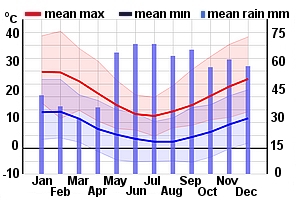Jump to Winery List
Bendigo Wine Region, Victoria
The diverse and large Bendigo Wine region is located in a typical Australian bushland setting, which includes some high quality agricultural land that provided excellent conditions growing grapes. Bendigo enjoys a mild climate all year round with an average annual temperature maximum of 20.4 degrees Centrigrade, with a mean of about 28 degrees during summer and 13° degrees in winter. The mean annual rainfall decreases as you move from south to north. The maximum annual average rainfall occurs in Creswick (756 mm), closely followed by Kyneton (753 mm) and Bendigo rainfall averages 550 mm. Further north the mean annual rainfall is minimal in Kerang (377 mm). The number of sunshine hours per day averages 8.7. The combination of outstanding natural beauty, wonderful food and wine, fabulous
accommodation, and a wide range tourist attractions and activities, combine to ensure that the Bendigo Region is a wonderful destination for short daytrips and weekend stays and for longer holidays. There are three general landscape based sub-regions in the Bendigo region; the Granite Slopes in the south-east, includes the towns of Castlemaine and Harcourt; Loddon Valley in the north west has a group of wineries clustered around Marong and Kingower; and finally the Golden Waters area in the south west includes the towns of Maryborough and Bet Bet. The region has a reputation as `The Winemakers' Region' because most of the wineries are family owned with the winery and cellar door facilities surrounded by the vineyards from which the wine is made. In most cases you can meet the owner and wine
maker when tasting the wines. The deep soils, spring rain and long hours of summer sunshine, are ideal for growing Shiraz and Cabernet Sauvignon. The most common white varieties grown include Chardonnay, Viognier and Sauvignon Blanc. The first grapes were planted in the region as early as1856, just after the start of the massive gold rush in the area. In 1873 the wine judges at the Vienna Exhibition commented on the Bendigo Hermitage that 'no Colonial wine can be that good'. By 1864 there were more than 40 vineyards in the Bendigo area. However, the disease Phylloxera virtually wiped out the vineyards in 1893. A gap of over 60 years followed until a local Bendigo chemist, Stuart Anderson, took the plunge ans planted vines at Balgownie in 1969. Many other growers and wine makes followed and
today there are over 20 vineyards and wineries in the region.
The Bendigo Wine Region includes nine districts :
Kingower ;
Lower Loddon ;
North Bendigo ;
Lower Campaspe ;
Upper Campaspe ;
Central Bendigpo ;
Castlemaine ;
Maldon ;
Maryborough


Search for a Winery
- Avonmore Estate, VIC
- Balgownie Estate, VIC
- Belvoir Park Estate, VIC
- Black Estate Vineyard, VIC
- Blackjack Wines, VIC
- Burnt Acre Vineyard, VIC
- Connor Park, VIC
- Ellis Wines,
- Glenwillow Vineyard, VIC
- Harcourt Valley Winery, VIC
- Killiecrankie Wines, VIC
- LanganookWines, VIC
- Long Block Estate,
- Lynnevale Estate, VIC
- Mandurang Valley Winery, VIC
- Mount Alexander, VIC
- Newbridge Wines, VIC
- Rivergate Wines, VIC
- Sanctuary Hill Vineyard, VIC
- Sandhurst Ridge Winery, VIC
- Sutton Grange Winery,
- Water Wheel, VIC
- Welshmans Reef, VIC
No Match for Your Search